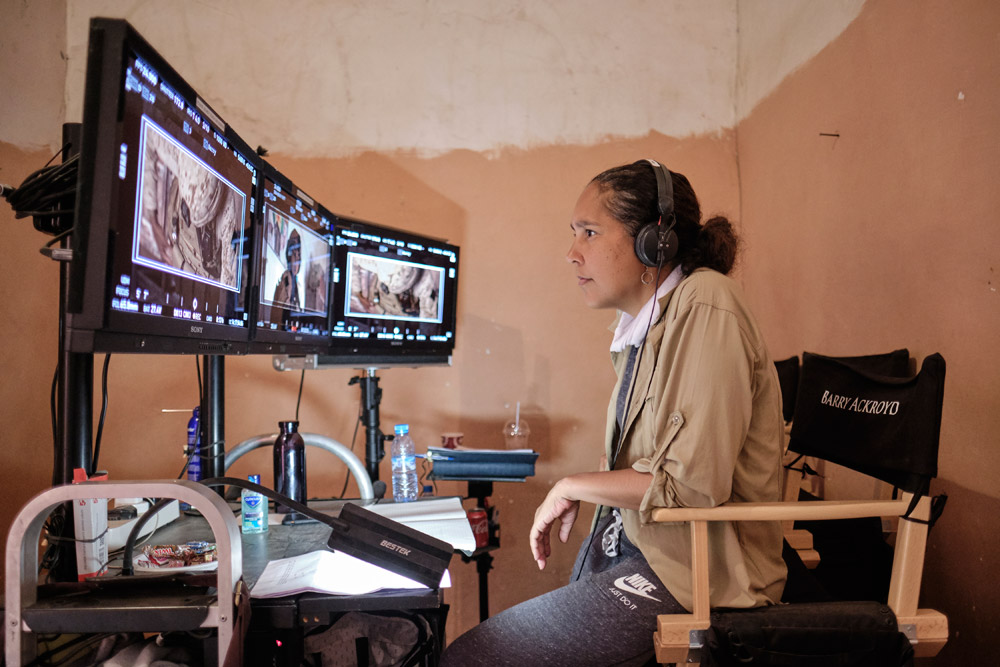It was only natural that when Gina Prince-Bythewood was approached with an offer to direct “The Old Guard,” she gave a lot of thought to time. After all, the central idea of Greg Rucka and Leandro Fernandez’s series of comics is about how a team of immortals that have turned their unique disposition into a lucrative business operating as mercenaries for the highest bidder.
As she thought about the team’s leader Andy (Charlize Theron) growing numb to the work she’s doing, increasingly anxious over the fact she’s become desensitized to taking the lives of others, Prince-Bythewood saw a compelling opportunity to explore the psychic scars that remain even after flesh wounds quickly heal when one has an eternity to contemplate their actions, and just as provocatively, the way in which it can take longer to see the good we do in the world when positive change often happens far more incrementally than evil. On this latter point, Prince-Bythewood could likely relate intimately when the opportunity to direct such a large-scale action extravaganza had eluded her even after laying her own claim to immortality with classics such as “Love & Basketball” and “Beyond the Lights,” though if you express your own anger that it took this long for the powers to be to see she was ready, she’s liable to turn this premise around to suggest those greenlighting Hollywood tentpoles weren’t yet ready for her.
“I love the direction it’s been moving in the last couple years in terms of being more action dramas,” says Prince-Bythewood, who already had been working on the “Spider-Man” spinoff “Silver & Black” when “The Old Guard” came her way. “The fact that I cried in both ‘Logan,’ which I loved so much, and ‘Black Panther,’ I loved that and I wanted my own opportunity to be in this big sandbox and bring my aesthetic and tell the kind of stories that I like to tell in this space.”
While anyone who had the hairs stand up on the back of their neck during “Love & Basketball” have known that every film of hers since has been an event, Prince-Bythewood’s first true event film doesn’t disappoint, having all the kinetic energy you’d expect from a director who ran track in college but continually reminds that the hardest working and most essential muscle is the heart. With Rucka delivering a sharp adaptation of his own books, “The Old Guard” follows the special ops squad into dicey territory when a shadowy ex-CIA officer (Chiwetel Ejiofor) contracts their services on a child abduction case in the South Sudan and while the mission threatens to expose their unique disposition, it leads to the revelation of a potential new member in Nile (Kiki Layne), an American Marine finishing a tour of duty in Afghanistan.
True to the genre, Nile joins a collection of diverse personalities in “The Old Guard,” but they’re noticeably more diverse than have graced a globe-trotting adventure of this size and scope on screen before, and when such a strong crew assembles on screen, it’s only fitting that Prince-Bythewood has brought some of her most cherished collaborators such as editor Terilyn Shropshire and cinematographer Tami Reiker along for the ride allowing her to make a movie that’s distinctly hers as she levels up, where dazzling set-pieces can give way to sinking into a sea of emotion with an introspective Frank Ocean track and a character can shrewdly suss out a location based on a hint of pomegranate and the use of hazelnut in a piece of baklava. Shortly before the film premieres on Netflix, the director spoke about how she made a blockbuster on her terms, crafting emotionally-charged fight scenes and figuring out how to have such high stakes in a film where death is not an option.
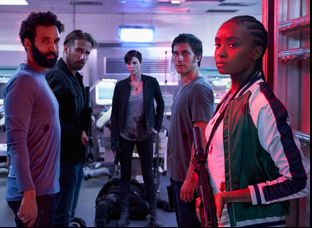 What got you excited about “The Old Guard”?
What got you excited about “The Old Guard”?
It was two-fold. I got a script sent to me by Skydance, which is a company that I love [with] the “Mission: Impossible” films, “Star Trek” and all the “Terminators,” so to get something from them, I knew this was something big, which was both exciting and scary. I didn’t know about “The Old Guard” comic, but I was familiar with Greg Rucka’s work with Lazarus and really loved what he does with female characters, so I just started reading and fell in love immediately. It felt like everything I had wanted to do in this space – the fact that there were two women at the head and that one was a young black female, and that these characters have depth, they moved me. They were searching for purpose, which is such a human thing and something that I could connect with, and I loved that this story kept surprising me. It’s this group of warriors from all these different backgrounds and cultures and sexual orientations and genders coming together to save the world — that’s the world I want to live in and I felt honored, honestly, to be the one to bring these characters to life.
The notion of immortality is given such interesting consideration in the film, which I understand you were somewhat responsible for in the developing this for the screen. Did your ideas evolve on it over time?
It absolutely evolved in reading the script. At times in my life, I have said I wish I could be immortal. I wish I could never die, not really understanding what that means, but just thinking about the aspirational parts of that – the courage that would give you, all the things that you would do if you knew you couldn’t die yet not really understanding what it would mean to live that long. In terms of these characters, [it was interesting] that they are here for a reason, but don’t know why but they are compelled to kill because taking one life saves many, and there is a toll to that.
That is something I wanted to bring in because I love action films, but often there’s this thing we are fed that there are no consequences to killing and there absolutely is, and in the research that I started doing in preparation to do this film, a book in particular on killing [Dave Grossman’s “On Killing: The Psychological Cost of Learning to Kill in War and Society”] really spoke about how for soldiers, the act of taking a life is as damaging psychologically as the fear of losing your life on the battlefield. I had never heard that before and it seemed to make perfect sense for both Andy and for Nile.
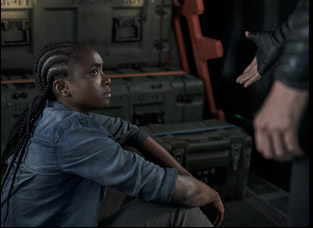 Throughout the film, you see so much of the characters in how they fight. When you’re figuring out the action sequences, are you bringing in the actors into those conversations as early as the stunt teams?
Throughout the film, you see so much of the characters in how they fight. When you’re figuring out the action sequences, are you bringing in the actors into those conversations as early as the stunt teams?
That was really important to me that the fights feel so character-driven and did have a story because the great fights that I had wanted to emulate and inspired me did just that, so that was in my early conversations with all the actors. Foremost, I wanted the best actors for this, but knowing that I wanted this to feel grounded and real, I was going to shoot the action in a certain way and I wanted to see the actors doing it and not stunt doubles. I wanted to be able to stay on longer takes and feel the emotion and tell the story through performance, so they knew early on that they had to put in that work. They all absolutely did and it affected my conversations with my stunt team as well [saying], “This is the story of the scene, this is what we need to tell, this is what I need to feel” and just building it with them.
Like the plane fight for example [with] Nile – how does she fight? Well, she’s a Marine, so that’s what she was taught in the Marine martial arts program, but knowing in the fight that frustration of not being able to touch Andy is going to build and build until she throws [that style of fighting] out and just goes back to the street and she just starts throwing these wild haymakers. Knowing that the stunt team would need to teach Kiki that, but also [having] Kiki understanding that part of it, all of that really aided in their [collective] “Why am I working so hard so I can do this well and put the story up on screen?”
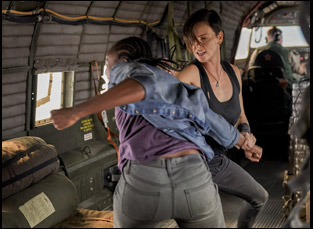 That plane sequence is amazing. Was it a challenge to figure out?
That plane sequence is amazing. Was it a challenge to figure out?
That was the very first thing we shot and Tami Reiker, the [cinematographer] and I were very intent on not giving ourselves a crutch [such as] having walls that could fly so we could put the camera anywhere. We wanted to be as confined as the two characters in that scene, so we built a life-size plane and that was high up in the air of this giant soundstage and on hydraulics to mimic the movement of the plane. And I hate to fly. [laughs] I’m deathly afraid of flying and being up there, every time they turned on the hydraulics, I would literally jump because my mind went to “Oh my God, we’re crashing.” So it took me a while to be able to calm myself so I could focus, but there was one moment where the hydraulics went nuts for a second, and I thought “Oh my God, I’m going to die shooting this movie I’ve dreamed about doing.” [laughs] They got it under control, but that was a scary moment.
That’s incredible when the two most memorable plane scenes I can think of are in this and “Beyond the Lights.”
[laughs] That’ll be my thing now.This may be silly to ask, but you’ve got a little kickboxing in your background – did that actually help you figure out ways to shoot it dynamically?
Yeah, having been in a ring and having hit and be hit, I wanted an audience to feel that, and it was such a great way to connect with my stunt team because they knew early on, “Oh she knows what she’s talking about.” I know what a good punch looks like. I know if something looked wack, and I certainly didn’t want my female characters to be seen that way, but I knew I wanted the camera to be in it, so I wanted the camera to be handheld and more at eye level. Very rarely did I have a shot that felt unnatural – that was maybe down on the ground or up high — I wanted to be in it so the audience is looking and seeing these punches are coming at them in the same way the fighters in the scene would.
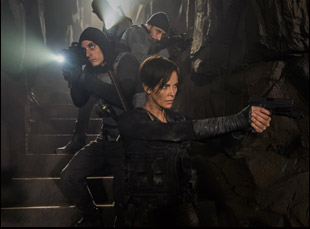 It was so exciting to see some of the action scored with songs, which has been a trademark of your work in the past. For something like the castle sequence, do you have a piece of music in mind well before shooting or developing ideas throughout?
It was so exciting to see some of the action scored with songs, which has been a trademark of your work in the past. For something like the castle sequence, do you have a piece of music in mind well before shooting or developing ideas throughout?
That’s one of my favorite parts of the process, so I certainly have songs that I use as I’m thinking about how I’m going to shoot it. I just have playlists for everything and I have an incredible editor Teri Shropshire, who shares a same love of music, so we’re constantly sharing songs that we feel touch on the themes of the movie or the characters, and we have a great musical supervisor Julia Michaels, who sends me hundreds of songs and it’s exciting when that perfect song pops up. But you never know until you get in there and you put a scene to music because songs for score, it’s got to enhance the scene, but it can’t take it over, so we’re always looking. I wanted to go against what is expected musically in a film like this because this tone was always going to be a balance between the fact that this is a violent film, but I never wanted it to feel like a celebration of violence and I hope the song choice helped me to achieve that.
When you’re editing with Terilyn Shropshire, this has a patience that’s unusual for an action movie, but doesn’t lose any of the energy you need. Was finding the rhythm any different with the demands of an action movie?
Yeah, this was absolutely the longest post we’ve ever had and going in, my mantra for the studio, for the producers and then for me and Terilyn was that the quiet moments of this film are as important as the big set-pieces. We have to care about these characters for these set-pieces and the action to mean something. But there is an assumption in films like this to “keep it moving, keep it moving, keep it moving” and get to the next action sequence, so we wanted to push back on that. It was a lot of trial and error [regarding] how much can we have, [like] “Yes, the character, it’s taking some time for her to walk from here to there, but in that moment, she is thinking. She is taking in what just happened. She is taking in moments.” And we felt like those little beats built our connection as an audience to the characters.
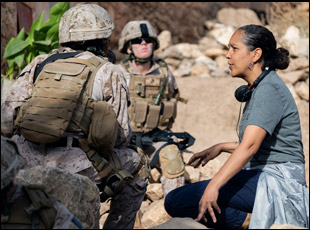 You’ve mentioned Tami and Terilyn, who you’ve worked with for years among other members of the crew of this. When were you in Marrakesh or any of these other far-flung locations, did you ever think to yourself, “Damn, look where we are now”?
You’ve mentioned Tami and Terilyn, who you’ve worked with for years among other members of the crew of this. When were you in Marrakesh or any of these other far-flung locations, did you ever think to yourself, “Damn, look where we are now”?
I have to say, I wanted to have people around me that I’ve come up with and I also wanted to have people who have done it before on this big scale because you want the best around you, but it is interesting, Teri and I spent 10 months in the editing room in a little box with no windows, stressing together to get this done and on the hardest days, we’d look at each other and say, “We built this from ‘Love & Basketball’ and we are now here at this level. We have to put in the work. We’ve got to get it done.”
But we were just grateful, and certainly to have somebody that I’m so close with, that I trust so implicitly who got to come on this journey with me [as Terilyn]… there’s so many great collaborators out there, especially great women who just don’t get the opportunity because their resumes don’t reflect it, but they don’t reflect it because people haven’t given them the chance. The fact that I’m so familiar with Teri or Tami’s work, I knew that they had the skills to do it, so it was worth the fight to have them onboard with me.
“The Old Guard” starts streaming on Netflix on July 10th.




